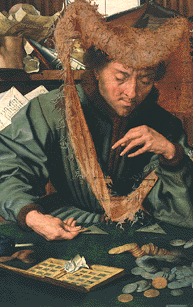|
________________________________________________________
________________________________________________________
[Note: as it turns out, Bodin's explanation was not entirely correct: prices in Europe had been rising since 1480, whereas the great silver mines of Potosi were only discovered in 1545 and took a considerable amount of time to become diffused in European money. There is also the anomaly that during 1570 and 1590, when gold and silver imports were at their height, prices actually declined.] John Locke (1692) took this idea and "stated" the Quantity Theory of Money as a general rule: if the supply of money is increased, the prices of all goods will rise. Locke applied this immediately: if money supply fell and the prices of goods fell, than the prices of foreign goods would rise relative to domestic goods "both of which will keep us poor" (Locke, 1692). Thus, Locke argued the Mercantilist line of maintaining a favorable balance of trade to ensure an inflow of money and thus that the price level of English goods remained higher than that of foreign goods. To most of the other Mercantilists, Locke's theory was peculiar. Should not lower prices for English goods, they asked, increase exports to other countries and make us wealthier? Locke's idea of money increasing prices but not increasing output was peculiar to them. The idea of money as a "veil" was, for them, almost an oxymoron. Nonetheless, Locke's idea has in fact adopted by many economic theorists since then - albeit, each with some difference. The questions that emerged were then "why" and "how" money affected prices without influencing output. To this question, four essential types of answer were given: (1) the original Quantity Theory; (2) the Cambridge Cash-Balance theory, (3) the Wicksellian theories; (4) the Walrasian theories -- all of which differ on several important concepts. But we should also note that the mechanisms underlying the Wicksellian theories were also applied to explain changes in output as well as prices - thereby contradicting the strict precepts of the "Quantity Theory". Indeed, that was one of Keynes's main contributions in his General Theory (1936). Since then, economics has gone back and forth over whether money affects prices or output. We have also recurrently reversed the question and talked about how prices and output in turn affect the quantity of money - a theory that is much more recent reflecting the more contemporary phenomenon of considering bank-created deposits as "money". Before we begin, let us consider some definitions: "neutrality" is the proposition that a change in the supply of money will not change output in the long-run. "Dichotomy" is the proposition that there is a strict division between the "real side" and the "money side" of the economy, i.e. changes in the money do not affect "real phenomena" such as output. Although many people (and many economists) have confused the terms "neutrality" and "dichotomy", there is a difference: neutrality only claims money is a "veil" in the long-run, whereas dichotomy asserts that money is a "veil" both in the long-run and the short-run. Dichotomy implies neutrality, but neutrality does not imply dichotomy. Many varieties of the theory of money have confused these terms. We should also come clear as to what "money" is. There are in fact many definitions of it. The strictest or "narrowest" definition is that money is merely coins, paper notes and reserves held at central banks. This is also referred to as M0 or "high-powered" money. Wider notions of money would include coins, notes and also checking deposits held by the public at commercial banks. This is also referred to as M1. Finally, one can go even wider and consider some savings accounts, money market accounts and even checkable mutual funds accounts as "money". These wider definitions are referred to as M2, M3, etc. depending upon the degree of "liquidity". By "liquidity" we mean the degree to which particular things can be used to settle a wide variety of transactions. Coins and notes are highly liquid as everyone accepts them in exchange for goods. Cheques are also widely (but not as nearly) accepted. (Note: credit cards are excluded because they are "loans" - the transaction is not completed upon using a credit card, but only deferred until the end of the month). The idea of money being defined by its "acceptability" often gives it the term "medium of exchange". But money also has other functions: it is a unit of account (i.e. prices of goods are expressed in terms of dollars, yen, francs as opposed to peanuts, blast furnaces or sewing machines); money is also a store of value: we exchange labor for food, but we rarely do so directly - we get paid in cash for labor and we use that cash to buy food later. In the meantime, the cash has "stored" the value of our labor. Finally, another idea that has gotten recent attention is the idea of money as a record of a credit transaction, but that would take us a bit too far afield. Another question imposes itself immediately: how much cash to we "desire"? Technically speaking, we usually don't "desire" money but only what money can buy. Indeed, one of the fundamental ideas underlying the "dichotomy" is precisely this. But there is a sense in which money facilitates exchange - like "oil in the machine" as our quote from Hume indicates. It is also possible that we actually "desire" money as a hedge against uncertainty, or for speculative purposes in financial markets, or even because it is "wealth" and we always like wealth. These issues have complicated the old idea of money as a "veil" because now it seems that money has indeed some "usefulness" in and of itself. This issue, lurching between seeing money being only a "veil" and then going on to claim it is nonetheless "desirable" has led to many twists and turns in the history of theories of money.
|
All rights reserved, Gonšalo L. Fonseca

